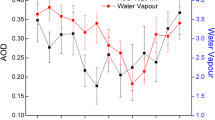Abstract
The paper reports the observations of the aerosol studies carried-out for three years (2004-2007) during the summers and winters at Kaikhali (22.0220 N & 88.6140E) lying in the east coast of India inside a special mangrove ecosystem: 'The Sundarbans'. Aerosol optical depths were measured using a five filter channel sunphotometer with wavelengths at 340, 500,870, 936 and 1020 nm respectively. The sampling site enjoys a tropical climate and is under the strong influence of the southwest or summer monsoon and weak northeast or winter monsoon. The mean aerosol optical depth (AOD) during the winters (2004-2007) for the filter channels 340, 500, 870, 936 and 1020 nm have been found to be 1.478, 1.014, 0.579, 0.541 and 0.523 respectively whereas for the summer periods, they have been found to be 1.173, 0.859, 0.603, 0.564 and 0.597 respectively. The mean values of the angstrom exponent calculated for the winter and summer months over the years 2004-2007 have been found to be 1.283, 0.999, 1.285 and 1.094, 1.167 and 1.91 respectively. Generally the higher angstrom exponent values during the winter periods over the years from 2004-2007 except for the year 2005-2006 indicate high ratio of smaller fractions to larger fractions. The values of Angstrom exponents observed at the site suggest that the aerosol comprise mostly of the small size particles. An attempt has been made in the paper to compare the aerosol optical depth and angstrom exponent values with another study conducted in a different coastal zone in India.




Similar content being viewed by others
References
Arndt, R. L., Carmicheal, G. R., Streets, D. G., & Bhatti, N. (1997). Sulfur dioxide emissions and sectorial contributions to sulfur deposition in Asia. Atmospheric Environment, 31(1997), 1553–1572.
Charlson, R. J., Anderson, T. L., & Rodhe, H. (1999). Direct climate forcing by anthropogenic aerosols: quantifying the link between atmospheric sulfate and radiation; Contr. Atmos. Phys., 72, 79–94.
Dani, K.K., Maheshkumar, R.S., Devara, P.C.S. (2003). “Study of total column atmospheric aerosol optical depth, ozone and precipitable water content over Bay of Bengal during BOBMEX-99”, Proc. Indian Acad. Sci. (Earth Planet. Sci.), 112(2), 205-221.
Frouin, R., Holben, B., Miller, M., Pietras, C., Kirk, K.D., Fargion, G.S., Porter, J., Voss, K. (2003). Sun and sky radiance measurements and data analysis protocols. In: Mueller, J.L., Fargion, G.S., MacClain, C.R. (Eds.), Ocean optical protocols for satellite ocean color sensor validation, Revision 4, Radiometric measurements and data analysis protocols, NASA/TM-2003-211621/Rev4-Vol-III, Vol-III. NASA, Goddard Space Flight Center, Greenbelt, MA, pp. 60–69 (Chapter 5).
Gabriel, R., Mayol-Bracero, O.L., Andrea, M.O. (2002). “Chemical characterization of submicron aerosol particles collected over the Indian Ocean”, Journal of Geophysical Research, pp. 107.
Gopal, B., & Chauhan, M. (2006). Biodiversity and its conservation in the Sundarban mangrove ecosystem. Aquatic Sciences-Research Across Boundaries, 28(3), 338–354.
Kazadis, S., Bais, A., Amiridis, V., Balis, D., Meleti, C., Kouremeti, N., et al. (2007). ” Nine years of UV aerosol optical depth measurements at Thessaloniki, Greece”. Atmos. Chem. Phys, 7, 2091–2101.
Marquez, C., Castro, T., Mahlia, A., Moya, M., Martinez-Arroyo, A., & Baez, A. (2005). “Measurement of aerosol particles, gases and flux radiation in the Pico de Orizaba National park, and its relationship to air pollution transport”. Atmospheric Environment, 39(21), 3877–3890.
Mitra, A. P., & Sharma, C. (2002). Indian aerosol: present status. Chemosphere, 49, 1175–1190.
Mukherjee, I., Mitra, A. P., Sharma, C., Mandal, T. K., Gupta, P. K., Singn, A., et al. (2005). “Measurement of particulates at a transboundary location, Kaikhali in Sundarban”, Indian Journal for Air Pollution Control (IJAPC), New Delhi Chapter, Vol V. No, 2, 114–118.
Mukherjee, I., Chakraborty, N., DebSarkar, A., & Mondal, T. K. (2010). “Observation on particulate matter over a period of 3 years at Kaikhali (22.0220 N, 88.6140E) inside a special mangrove ecosystem: Sundarbans”. Journal of Environmental Engineering, ASCE, 136(1), 119–126.
Operation Manual of Microtops II Sunphotometer by Solar Light Co Inc., USA.
Pietras, C., Miller, M., Kirk, K. D., Frouin, R., Holben, B., & Voss, K. (2003). Calibration of sunphotometer and sky radiance sensors. In J. L. Mueller, G. S. Fargion, & C. R. Mac-Clain (Eds.), Ocean optical protocols for satellite ocean color sensor validation, Revision 4, Instrument specifications, characterization and calibration, NASA/TM- 2003-211621/Rev4-Vol-II (pp. 34–45). Goddard Space Flight Center, Greenbelt, MA: Vol-II. NASA.
Ramanathan, V., Crutzen, P. J., Mitra, A. P., & Sikka, D. (2002). The Indian Ocean Experiment and the Asian Brown Cloud. Current Science, 83(8), 947–955.
Reddy, M. S., & Venkataraman, C. (2002a). Inventory of aerosol and sulphur dioxide emissions from India I—fossil fuel combustion. Atmospheric Environment, 36, 677–697.
Reddy, M. S., & Venkataraman, C. (2002b). Inventory of aerosol and sulphur dioxide emissions from India II-Biomass combustion. Atmospheric Environment, 36, 699–712.
Chowdhury, B.R., Vyas, F., Pradeep, I. (2005). “The Sundarbans—a pictorial guide”, Published in 2005 By Rupa & Co, 115
Singh, S., Singh, B., Gera, B. S., Srivastava, M. K., Dutta, H. N., Garg, S. C., et al. (2006). A study of aerosol optical depth in the central Indian region (17.3-8.60 N) during ISRO-GBP field campaign. Atmospheric Environment, 40, 6494–6503.
Six, D., Fily, M., Blarel, L., & Goloub, P. (2005). First aerosol optical thickness measurements at Dome C (East America), summer 2003-2004. Atmospheric Environment, 39, 5041–5050.
Suresh, T., & Desa, E. (2005). “Seasonal variations of aerosol over Dona Paula, a coastal site on the west coast of India”. Atmospheric Environment, 39, 3471–3480.
Acknowledgement
We thank the Council of Scientific and Industrial Research (CSIR), Government of India, for entrusting us the responsibility of carrying out the measurements during the winter and summer periods from 2004 to 2007. We are much grateful to Jadavpur University; without whose active support, it would not have been possible to make this endeavor a success.
Author information
Authors and Affiliations
Corresponding author
Rights and permissions
About this article
Cite this article
Mukherjee, I., Chakraborty, N. & Mandal, T.K. “Observations on Aerosol Optical Depth Over a Period of 3 Years at Kaikhali (22.022°N, 88.614°E) Inside a Special Mangrove Ecosystem—The Sundarbans”. Water Air Soil Pollut 215, 477–486 (2011). https://doi.org/10.1007/s11270-010-0492-z
Received:
Accepted:
Published:
Issue Date:
DOI: https://doi.org/10.1007/s11270-010-0492-z




